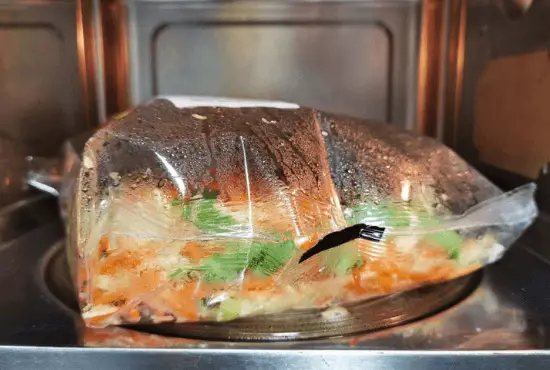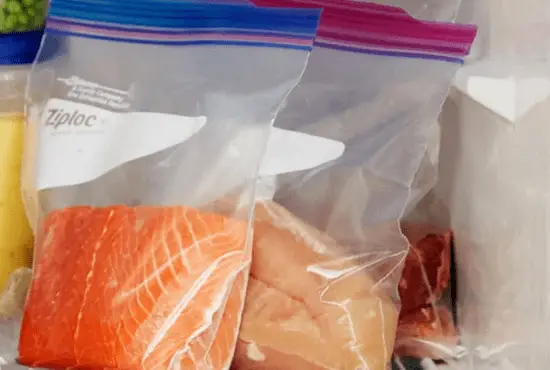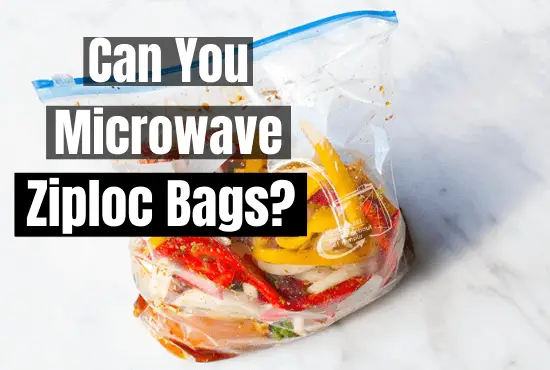Stepping into the magical place –your kitchen with the puzzling idea of Microwaving food in Ziploc Bags will certainly leave you to inquire if they are microwave safe.
Keeping in mind the temperature limit and certain basic information, discover with no trouble if you can microwave Ziploc bags or not?
Microwaving Ziploc Bags for defrosting and reheating within a temperature limit of 74°C is considered microwave-safe only. Avoid using Ziploc bags to be microwaved for cooking and steaming of veggies as it requires a high heating temperature. A sandwich and freezer Ziploc Bags labeled microwave-safe are preferred best for its usage.
Table of Contents
Are Ziploc Bags Microwave Safe?
The Ziploc brand has marked its production of bags as microwave-safe as it follows the safety requirements of the (Food and Drug Administration) FDA. These flexible and durable Ziploc Bags are well-manufactured of thin layered plastic known as “film.”
It consists of two types of plastics: Low-density Polyethylene (LDPE) marked as number 4, and Linear Low-density Polyethylene(LLDPE) marked as number #2 to describe their recycling process.
Both these plastics are stable enough to withstand defrosting and reheating temperatures. Also, you can buy the desired form of plastic Ziploc Bag by figuring out the label displayed at the bottom of it.
At what temperature the Ziploc Bags get melted?
Polyethylene plastic starts to soften when the temperature falls at about 90°C or 195°F. It is suggested to maintain the temperature limit below 75°C or 175°F. So, you can avoid the melting of Ziploc bags.
For using an off-brand Ziploc pack it is recommended to check out the Microwave safe label on the product or contact the creator website. Always avoid microwave plastic bags made with polyvinyl chloride (PVC) and bags that contain Bisphenol-A chemical.
Are Ziploc Bags BPA-free?
The BPA chemical is mostly found in harder plastics like polycarbonate. So, plastics like LDPE and LLDPE have no traces of such harmful chemicals. The BPA and dioxin-free Ziploc Bags are also recyclable and eco-friendly.
Is It Safe To Cook Food In Ziploc Bag In Microwave?

According to the Ziploc brand instructions, it is not safe to cook food in Ziploc bags. They only approve Ziploc bags as microwave safe for defrosting and reheating. It is because cooking requires a great deal of heating temperature, which certainly is higher than the melting point of the polyethylene plastic.
Steaming veggies in Ziploc bags to be microwaved is also not recommended. It is because it requires a large amount of heat transfer. The Steam possesses a higher energy level (9X) than boiling water. It thus can create exceeding pressure inside the bag to explode.
Microwaving Food in Ziploc Containers is also considered microwave safe due to its formation of mixed plastics called polypropylene. They have a higher melting point (160°C or 320°C) as compared to polyethylene. However, do not leave the Ziploc container in the microwave for a long time as the heating process has much greater speed.
Microwaving Food in Ziploc Sandwich Bags is only considered perfect for use if it has a “microwave safe” label on it. Avoid using a regular plastic bag for this purpose.
Ziploc freezer bags are considered microwave safe due to their makeup ability to sustain the process of defrosting and reheating. Still, you should take great care from overheating it.
Some other microwave-safe Ziploc bags include
- Vacuum zipper bags
- Royal Double Zipper bags
- Ziploc Easy Open Tabs
- Slider Storage Bags
- Grab-and-go Snacking bags
- Stand and Fill big bags
- Gallon Storage bags
- 50-quart storage bags
How To Microwave Food In Ziploc Bags?

Here is a list of helpful guidelines to make sure you microwave the food in the Ziploc bags correctly:
- Place small pieces of food inside the Ziploc bag to be microwaved. It will help in the distribution of heat and faster the process of reheating. By doing so, there will be less chance of overheating.
- While reheating fat and sugar always set the reheating limit at a low temperature. These molecules extract a greater amount of electromagnetic waves and can quickly result in the melting of your Ziploc bag.
- Always keep the zipper of the Ziploc bag unzipped. The recollection of vapor molecules due to locked zip causes heat expansion. The extra build-up pressure inside these bags usually causes small explosions.
- Set your microwave at optimum power setting and reheat the food at intervals of 30 seconds. By doing so, you can certainly notice any signs of warping or softening of the Ziploc bag.
- The best time to add sauces to your food in a Ziploc bag is the last round of 30-second. Liquids can be heated in a microwave in no time and if added at the start can eventually cause irregular distribution of heat temperature.
- Avoid reheating crispy foods inside the Ziploc bags as it will create humidity, and the food will get wet and soft. So, instead of bags, I prefer to use napkins for this purpose.
How Long Can You Microwave Ziploc Bags?
As it is clear from the above discussion that we need to set up an optimum temperature below the melting point. However, the microwave is adjusted by time and not the temperature limit. The calculated time to reach 75°C or 175°F is, therefore, less than 2 minutes.
Although the manufacturer has not clearly stated any specific time limit, it is considered best to microwave Ziploc bags within the optimum power limit. Complete the Microwaving process in intervals of 30 seconds to ensure the Ziploc bag is safe from overheating. If it starts getting softened, remove it quickly.
Additional Safety Tips For Microwaving Ziploc Bags
To make sure the reliable Ziploc bags can be used efficiently, here are some of the safeguarding tips according to the manufacturer’s directions.
It is strictly advised not to cook food in Ziploc bags. You can only carry out defrosting and reheating of your food.
If you witness the melting or de-coloring of Ziploc bags, it is recommended to throw them away immediately.
Take greater care of the inner surfaces of Ziploc bags. Avoid using scratched surfaced bags, as the chemical reactions inside them shall contaminate your food.
Always check out the “microwave safe” label at the bottom of the item. And if you find microwave Ziploc containers with recycling numbers #3 and #7, do not use them in the microwave.
Place the Ziploc bag on a microwave-safe turntable. When the food gets microwaved, take it out with great care. Always be cautious about overheating!
Conclusion
To sum up, the Microwave safe Ziploc Bags are specially made stable from plastics like polyethylene and polypropylene. These recyclable and BPA-free bags ensure to cause no health issues. All other plastic bags and bottles bought from grocery stores are strictly prohibited.
However, you must always look for the manufacturer’s website and “microwave safe” label for its proper use.
Ziploc Bags can endure the optimum temperature limit for defrosting and reheating. Avoid using Ziploc bags for cooking and steaming and never overfill them as it takes more time for reheating process. The optimum temperature required for microwaving food in these bags is below 75°C or 175°F. While microwaving food in Ziploc bags keep the zipper unsealed.
It is suggested to set up the microwave in low or medium power range and microwaving the Ziploc bag between 30-seconds intervals. Do not use Ziploc bags for microwaving more than once as it may have completed its duration of microwave durability. By doing so, you may risk leaching chemicals into your food.
Frequently Asked Questions
Are Ziploc Bags sterile?
Yes, Ziploc Bags are purely sterile. These recyclable bags are produced at a sultry and hot temperature with a higher speed to give them flexibility and durability. As soon as the bags are manufactured, the machines seal off them finally.
How do you know plastic bags are microwave-safe?
First, check the microwave symbol at the bottom of the item, indicating either squiggly lines or a dish set below radiation waves. You can also look for Plastic bags having numbers such as #2, #4, and #5 that suggest the product to be microwave safe.
Is it safe to microwave plastic bags?
The plastic considered microwave safe is Low-density Polyethylene, Linear Low-density Polyethylene, and Polypropylene. Only use plastic bags with a “microwave safe” label. All other plastic bags like water bottles and plastic jars containing dairy products and fats are not microwave-safe.
Recommended Readings:



